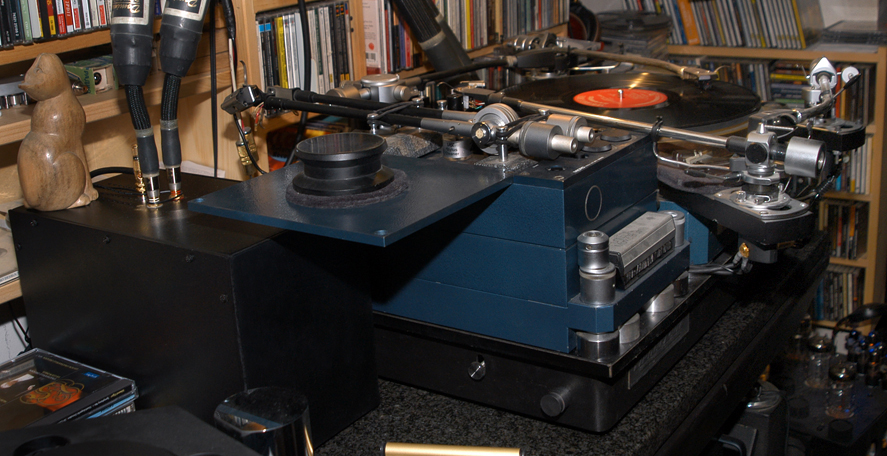Rerurn to Romy the Cat's Site
In the Forum: Analog Playback
In the Thread: The last phonocorrector: “End of Life" Phonostage
Post Subject: OK, it is over. Some preliminary follow ups.Posted by Romy the Cat on: 5/31/2008
I spent a bigger part of day today to finish the “End of Life" Phonostage, there were many things to do but it is now over. Done! Complete! Amen! I it closed up and sat in it’s permanent place.

A few observations looking back. First, I spent a LOT of time trying to fine tune the RIAA curve. I use the test LP with 20-20K sweeps. I use Jim Hagerman’s contra-RIAA little tool, driving the RTA and scope from generator. I use my Wavelab’s phenomenal FFT meter driving the Phonostage into Pacific Microsonics analog-to digital (this A/D calibrated mind-bogglingly well). I usually use the Wavelab’s FFT and Phase meters to help myself to setup cartridges – very covenant. Anyhow, to my displeasure I learned that the contra-RIAA devise was slightly off at HF, so I end up not to use it and used other means.
In the end of everything I was able to get very nice response. The response is nice and flat with 0dB at 18.1Hz and 0dB at 15.600Hz. It has plus 0.2dB from 1500 to 3500 which I feel is not a big deal. (Juts for my future reference: the values of the feedback capacitors have without de-soldering capS from the circuit are: 110pF= 136.2pF and 330pF=372pF)
I found a very good grounding schema and the self noise this corrector of 26db+48dB=72dB gain is better than good – it has absolutely no noise. The previous adaptation had no problem but this one took noise even further – there is no difference for the system between CD input and phonostage input, and do not forget that we are taking about 109dB sensitive system. I presume that my new construction techniques (mounting everything short point-to-point on a think copper plate that used as a ground terminal) do help. What I also detected over the second part of day playing the corrector that it looks like the gas regulation helps with good with electricity. Apparently the gas tubes shunt all power line dirt – a promising sign.
Sonic results. It is hard to say. I feel that there is no sonic difference between my former version and the new one, the new phonostage is too fresh, the caps, the PS, the disturbed Dominus cables the total assembling - perhaps I need to return to the subject of sound after 500 hours. The new phonostage has the following changed compare to the former one:
1) Fix biasing on the second stage instead of the former automated
2) Different filament and anode PS, the anode supplies are gas regulated.
3) Better construction techniques (the former version was my very first DIY Audio attempt since I began practicing the US version of High-End Audio)
4) V-Cap coupling capacitors between the first and second stage
5) More immediate connection between the ET2 transformer and first grid
I did not study or observed the incremental changes, let see how it will turn out all together.
Preliminary conclusion: very good. It looks like the essence of the ET+834PT was not lost (that what I was afraid and this is why I built a new corrector and kept the original intact – just in case). The new corrector did not developed it’s full bass yet but I know the Nichicon caps and the disturbed Dominus – it shell come later. All together the sound as I expected – three is nothing alarming at this point. Some unique ET+834PT quietly are still there. For instance the ET+834PT is the only know to me phonostage that is capable to play (if needed) without HF. I mean any good phonostage I tried threw very high quality HF, demonstrating that analog HF might be very-very good. Only Boulder 2008 phonostage was a minor exception that was able to throw non-presumptuous HF up to a degree. The ET+834PT takes this approach to extreme – it has no HF at all and it pitch HF into the game ONLY when it is necessary. You listen it and it feels at beginning that there is not enough HF but you add .5dB and realize that it is how live Sound sounds. There is no HF in live sound; there is Space but no HF itself. ET+834PT does the necessary HF’ space tricks without actually making HF themselves. I can go on in many other specific distinctive characteristics of the ET+834PT but it is not my objectives at this point. The important is that the new procurator looks like preserve them all – God bless the smart Tim de Paravicini’s design of amplified Miller capacitance and feedback to high impedance.
Rgs, Romy the CatRerurn to Romy the Cat's Site